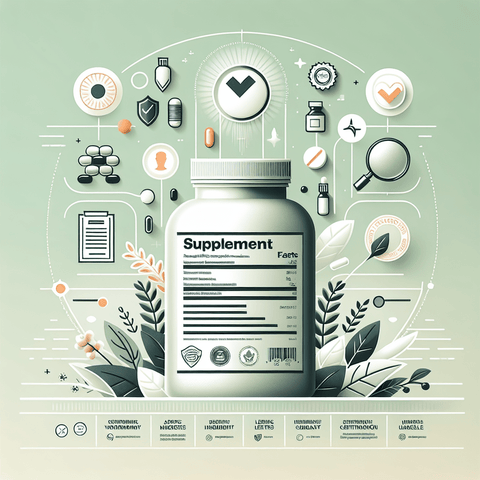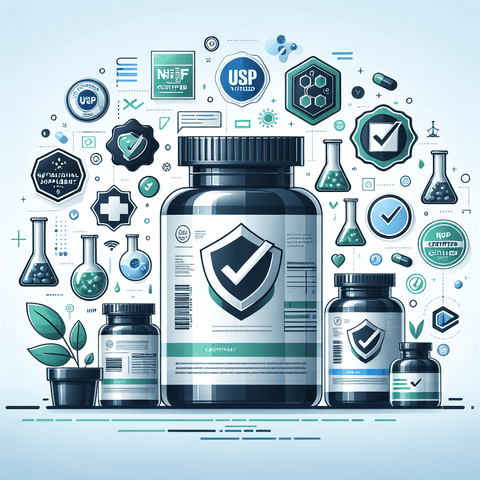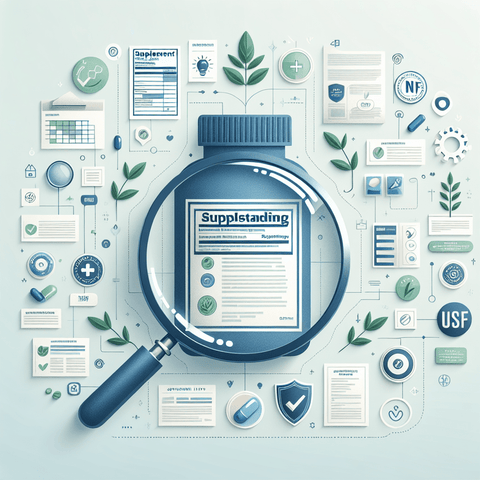Introduction
In today’s health-conscious society, dietary supplements have become a staple for many individuals seeking to optimize their well-being. From boosting immunity to enhancing athletic performance, supplements promise a range of health benefits. However, with the surge in supplement consumption, concerns about the transparency and accuracy of product labeling have grown. How can consumers be sure that what is on the label truly reflects what's inside the bottle? Misleading or confusing labels can lead to health risks, financial waste, and missed health opportunities. Understanding supplement labels is not just about reading the fine print—it’s about empowering yourself to make safer, smarter health choices.
This comprehensive guide aims to decode the complexities behind supplement labels. We will explore regulatory standards, how to interpret ingredient lists, the significance of third-party verifications, and how to identify trustworthy products. By the end of this article, you’ll be equipped with the tools to scrutinize labels confidently, understand what the claims truly mean, and select supplements that align with your health goals. Let’s begin this journey toward transparency and informed decision-making, ensuring your supplement choices are both safe and effective.
Supplement Labels: Your First Clue to a Trustworthy Nutritional Supplement
Supplement labels serve as the primary interface between consumers and the products they purchase. They are designed to provide essential information about the supplement’s contents, ingredients, usage instructions, and safety considerations. A well-structured label not only informs but also helps you assess the quality and authenticity of a product.
The key elements that should be included on every supplement label are the product name, a Supplement Facts panel, a list of ingredients, serving size, manufacturer contact details, expiration date, and warnings or disclaimers. The Supplement Facts panel is particularly crucial as it provides detailed nutritional information per serving. Additionally, labels should specify the form of nutrients used, the amount per serving, and any potential allergens.
However, misconceptions abound. For instance, some labels might exaggerate benefits or obscure ingredient sources. Common pitfalls include proprietary blends that hide ingredient quantities, vague descriptions, or misleading health claims. Reading labels carefully allows consumers to avoid products laden with fillers, artificial additives, or allergens, mitigating health risks and ensuring value for money. Here’s an example of a typical supplement label layout:
- Product Name - Supplement Facts - Serving Size & Servings Per Container - List of Ingredients - Proprietary Blend (if applicable) - Other Ingredients (fillers, binders) - Warnings & Cautions - Manufacturing Details & Expiry Date
Understanding this layout is the first step toward making informed choices and avoiding pitfalls that compromise health or wallet.
Supplement Labeling Regulations: Ensuring Accuracy and Consumer Protection
To safeguard consumers, regulatory agencies like the U.S. Food and Drug Administration (FDA), Federal Trade Commission (FTC), and laws such as the Dietary Supplement Health and Education Act (DSHEA) of 1994 play crucial roles. These bodies set standards that manufacturers must adhere to for labeling accuracy, safety disclosures, and truthful marketing.
In the United States, DSHEA classifies dietary supplements as food products rather than drugs, which means they are subject to fewer pre-market regulations. However, supplement companies are still required to ensure their labels are truthful and not misleading. The FDA monitors compliance and can issue warnings or recall products that violate standards. Similarly, third-party organizations monitor manufacturing practices and label accuracy through certifications and audits.
International regulations vary; for example, the European Food Safety Authority (EFSA) enforces strict guidelines on health claims and ingredient disclosures. In regions with robust regulation, you’ll likely find more accurate and transparent labels. However, some manufacturers might exploit regulatory gaps or loopholes. Signs of compliance include the presence of batch numbers, clear ingredient sourcing, and adherence to Good Manufacturing Practices (GMP). Conversely, red flags include vague claims, missing contact information, or inconsistent labelling details.
By learning to identify signs of regulatory compliance, consumers can choose products that meet safety standards. Verifying the presence of certifications from recognized organizations is a practical way to ensure quality. Always remember that regulatory violations and recalls are indicators of products to avoid, emphasizing the importance of vigilance when selecting supplements.
Ingredient Transparency: Knowing What You’re Really Taking
Full ingredient disclosure is fundamental for safety and efficacy. Trustworthy supplement labels list every ingredient, including active compounds, excipients, fillers, binders, preservatives, and potential allergens. Transparent labels typically avoid proprietary blends or, at minimum, disclose ingredient quantities within those blends, enhancing consumer confidence.
Understanding the ingredient list involves looking beyond the common ingredients. For example, a supplement claiming to boost immunity might contain Vitamin C, zinc, and herbal extracts. Check if the amounts per serving align with scientifically supported dosages. Also, discern whether ingredients are natural, synthetic, or animal-derived, especially if you have ethical or health-related preferences.
Vague descriptions like “plant extracts” or “proprietary blends” can hide undisclosed ingredient proportions, potentially masking allergens or unsafe additives. Some labels may list artificial colors, preservatives, or fillers that serve no nutritional purpose but could cause adverse reactions.
To spot dishonest labeling, look for specific ingredient names and quantities. Legitimate products should clearly specify sources—like “ascorbic acid (vitamin C from acerola cherry).” Being vigilant enables you to avoid hidden allergens or unwanted additives that could affect your health. Importantly, undisclosed ingredients may compromise safety, especially in sensitive populations or those with allergies.
The Supplement Facts Panel: Decoding Nutritional Information
The Supplement Facts panel is your go-to resource when evaluating a supplement’s nutritional content. It presents serving size, servings per container, and a list of nutrients with their respective amounts. By understanding this panel, consumers can assess whether a product provides the dose necessary for their health goals.
Typically, the panel includes macro-nutrients (like carbohydrates, proteins, fats), micro-nutrients (vitamins and minerals), and bioactive compounds (herbal extracts, antioxidants). It also displays % Daily Values (DV), indicating how much of each nutrient contributes to a daily diet based on general nutrition guidelines. Recognizing this helps prevent overconsumption or underdosing of key nutrients.
Critical analysis involves checking if the label’s claimed benefits align with actual nutrient quantities. For example, a vitamin D supplement with only 100 IU per serving might be inadequate for deficiencies, whereas a dose of 2000 IU could be considered more appropriate depending on your needs. Be wary of exaggerated claims—labels that promise “miracle” effects without evidence often misrepresent actual contents.
Mislabeling or inaccuracies in the facts panel can be signs of regulatory violations. For instance, if the stated nutrient amount exceeds safe intake levels or is significantly lower than what manufacturers claim elsewhere, it warrants skepticism. Always cross-reference with trusted sources and, if possible, consult healthcare professionals for personalized advice.
Verified Supplement Claims: Separating Fact from Fiction
Supplements often feature claims like "supports immune health" or "boosts energy," but not all claims are backed by scientific evidence. Verified claims are supported by third-party testing and conform to regulatory standards. Recognizing credible claims requires understanding the role of independent verification organizations.
Third-party testing organizations like NSF International, United States Pharmacopeia (USP), and Good Manufacturing Practices (GMP) certification programs verify the quality, potency, and safety of supplements. Labels displaying seals from these organizations signal that the product has undergone rigorous testing beyond regulatory requirements.
Recognized verified claims are specific and substantiated, such as USP Verified or NSF Certified for sport. These seals assure consumers that the product contains what it claims without contaminants or adulterants. Beware of vague or exaggerated marketing tactics, like “superior,” “total,” or “miracle,” which often lack scientific backing.
Case studies illustrate the difference: a supplement with a USP Verified seal reliably provides the listed nutrients, while a product making unverified claims might contain undeclared substances or contaminants. Always look for certification seals and verify their validity on the certifier’s website for added confidence.
Understanding Supplement Certifications: Adding Trust to Your Purchase
Certifications from independent organizations add an extra layer of assurance to supplement quality. The most common certifications include GMP (Good Manufacturing Practices), NSF International, and USP Verified seals. These are designed to assure consumers of manufacturing quality, safety, and label accuracy.
GMP certification indicates that the manufacturer adheres to stringent standards ensuring consistency, safety, and quality control during production. This is foundational for supplement safety and efficacy.
Specialized seals like NSF and USP verify specific aspects such as label accuracy, absence of banned substances, and contaminant testing. These certifications are especially valuable for athletes, pregnant women, or individuals with health sensitivities.
Additional certifications, such as organic, non-GMO, or allergen-free labels, provide further confidence regarding ingredient sourcing and processing standards. Always verify these certifications on the certifier’s official website, not just the label, to confirm their legitimacy.
Choosing products with recognized certifications enhances safety, quality, and transparency. When shopping, look for seals prominently displayed on packaging and verify them online when in doubt.
Conclusion
Decoding supplement labels may seem daunting at first, but with a clear understanding of regulatory standards, ingredient disclosure, and third-party verifications, consumers can greatly improve their purchasing confidence. Accurate labels provide vital information about safety, potency, and authenticity—crucial for making health-enhancing choices.
Being an informed consumer involves meticulously reading labels, recognizing misleading marketing, and understanding the significance of certifications. Always consider consulting healthcare professionals for personalized advice, especially when dealing with deficiencies or health conditions.
Remember, your health is your most valuable asset. Prioritize transparency, quality, and safety when selecting supplements, and don’t hesitate to seek out products that meet high standards of integrity. Making educated choices helps ensure your supplement regimen will support your overall well-being effectively and safely.
Call to Action
Have you encountered confusing supplement labels or made a surprising discovery about product quality? Share your experiences below and help others become more aware of the importance of label literacy. For trusted supplement options, you can explore reputable categories like Vitamin C for immunity, Vitamin D sources and safety, or Omega-3 supplements. If you want to learn more or find high-quality supplements, visit Topvitamine for a wide selection backed by quality assurance. Staying informed is the first step toward smarter health choices!
Q&A Section
1. Why is reading supplement labels important?
Reading supplement labels helps you understand exactly what ingredients and nutrients are in the product, avoid allergens and fillers, verify the authenticity of health claims, and ensure the product meets safety standards. This reduces health risks and prevents wasted money on ineffective or unsafe products.
2. What should I look for on a supplement label to ensure quality?
Look for a complete ingredient list, serving size, nutrient amounts, % Daily Values, manufacturing and expiration dates, contact information, and third-party certifications like USP or NSF. Additionally, check for clear disclosures and avoid proprietary blends that hide ingredient quantities.
3. How can I spot misleading or false claims on supplement labels?
Be wary of vague language or exaggerated promises such as “miracle cure” or “totally improve health.” Verify claims with scientific evidence or third-party verifications, and check for certification seals. If in doubt, consult healthcare professionals or trusted sources.
4. What role do third-party certifications play in supplement safety?
Third-party certifications confirm that products meet strict standards for purity, potency, manufacturing practices, and label accuracy. They add an extra layer of trust beyond regulatory requirements, ensuring the product is safe and contains what it claims.
5. How can I use this knowledge to make better supplement choices?
Apply critical reading skills when examining labels, prioritize products with credible certifications, research ingredients for safety and efficacy, and seek advice from health professionals when needed. This approach helps you choose supplements that are both effective and safe.
Important Keywords
- Supplement labels
- Decoding supplement facts
- Supplement safety
- Third-party verification
- Ingredient transparency
- Regulatory standards
- Certifications (GMP, USP, NSF)
- Healthy supplement choices
- Label accuracy
- Consumer empowerment



